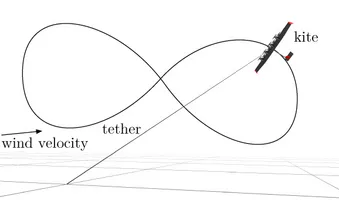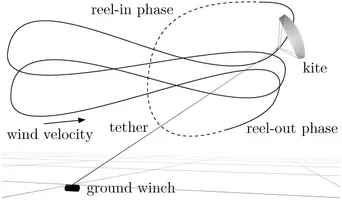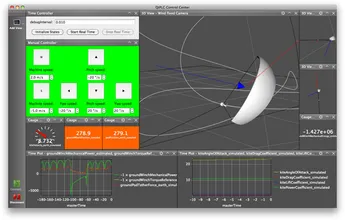Crosswind Kite Power
Research Foci
- Kite power concepts.
- Multidisciplinary modeling and optimization of power generating kites.
- Control of power generating kites.
Contact
Links
- kiteKRAFT Project website: http://www.kitekraft.de
- Youtube channel of Makani/Google/X, developing crosswind kite power plants and showing how such power plants look like: https://www.youtube.com/channel/UC-iMZJ8NppwT2fLwzFWJKOQ
Short Description
Kites, or tethered wings, are promising alternatives to harvest wind energy: As shown in Fig. 1, a (rigid) kite is flown in crosswind motions like figure eights (or alternatively circles). The kite has onboard turbines and generators to generate electrical power which is sent to the ground via electric cables integrated in the tether. Due to the high speed of the kite, the relative wind speed at the kite is about a magnitude higher than the actual wind speed, so that the onboard turbines can be small. This concept is called "drag power".
A second possibility for crosswind kite power is shown in Fig. 2: A kite (from soft materials like a paraglider or alternatively from rigid materials like a glider) is tethered to a winch on the ground which is connected to an electrical drive. The kite is flown in crosswind motions with a high lift force and pulls the tether from the winch. Energy is generated by operating the winch drive as generator (generative braking). When the maximum tether length is reached, the kite is flown to a low force position like the zenith, and/or pitched down, and reeled back in. A rigid kite can also dive towards the ground winch for minimal reel in time. During the reel-in phase, only a fraction of the generated energy is dissipated by operating the winch drive as motor. This concept is called “lift power”.
Both concepts can generate the same amount of power. Compared to conventional wind turbines, crosswind kite power promises to harvest wind energy at higher altitudes with stronger and steadier winds, but only by needing a fraction of the construction material. Hence, it promises to have a higher capacity factor, lower capital investments, and in the end a lower Levelized Cost Of Electricity (LCOE). Mechanical output powers of two megawatts were already achieved by a commercial soft kite by the company SkySails. A drag power rigid kite with a rated electrical power of 600 kW is currently under development by the company Makani Power/Google.
To contribute to solutions of the crosswind kite power challenges, research at TUM/EAL focuses on a number of aspects. Below is a list of our publications (most of them peer-reviewed). Small-scale demonstrators are beeing built to verify theories and concepts. Moreover, conceptual studies are performed. Fig. 3 shows a screenshot of the in-house developed simulation framework.
Publications
- Lorenzo Fagiano, Manfred Quack, Florian Bauer, Lode Carnel, and Espen Oland. “Autonomous Airborne Wind Energy Systems: Accomplishments and Challenges”. In: Annual Review of Control, Robotics, and Autonomous Systems, Vol. 5, No. 1, 2022. doi: 10.1146/annurev-control-042820-124658. url: https://doi.org/10.1146/annurev-control-042820-124658.
- Florian Bauer. “Multidisciplinary Optimization of Drag Power Kites”. Dissertation. Technical University of Munich. 2021. download: https://mediatum.ub.tum.de/?id=1484087
- Florian Bauer, Hannes Börngen, Ralph M. Kennel. “Power Electronic Topologies of Drag Power Kites”. In: Book of Abstracts of the Airborne Wind Energy Conference 2019. Ed. by Roland Schmehl, and Oliver Tulloch. Delft University of Technology, and University of Strathclyde Glasgow, 2019, pp. 148–151. isbn: 978-94-6366-213-0. doi: 10.4233/uuid:57fd203c-e069-11e9-9fcb-441ea15f7c9c. url: https://repository.tudelft.nl/islandora/object/uuid:57fd203c-e069-11e9-9fcb-441ea15f7c9c?collection=research. Conference video available from: http://www.awec2019.com. download: Slides-PDF.
- Simon Watson, Alberto Moro, Vera Reis, Charalampos Baniotopoulos, Stephan Barth, Gianni Bartoli, Florian Bauer, Elisa Boelman, Dennis Bosse, Antonello Cherubini, Alessandro Croce, Lorenzo Fagiano, Marco Fontana, Adrian Gambier, Konstantinos Gkoumas, Christopher Golightly, Mikel Iribas Latour, Peter Jamieson, John Kaldellis, Andrew Macdonald, Jimmy Murphy, Michael Muskulus, Francesco Petrini, Luca Pigolotti, Flemming Rasmussen, Philippe Schild, Roland Schmehl, Nafsika Stavridou, John Tande, Nigel Taylor, Thomas Telsnig, Ryan Wiser. “Future emerging technologies in the wind power sector: A European perspective”. Renewable and Sustainable Energy Reviews, Volume 113. 2019. doi: 10.1016/j.rser.2019.109270. url: http://www.sciencedirect.com/science/article/pii/S1364032119304782. download: Full Paper-PDF.
- Florian Bauer, Daniel Petzold, Ralph M. Kennel, Filippo Campagnolo, and Roland Schmehl. “Control of a Drag Power Kite over the Entire Wind Speed Range”. AIAA Journal of Guidance, Control, and Dynamics. July 3, 2019. doi: 10.2514/1.G004207. url: https://arc.aiaa.org/doi/10.2514/1.G004207. download: Preprint-PDF.
- Florian Bauer and Ralph M. Kennel. “Design Sensitivities of Drag Power Kites”. In: 8th Energy Colloquium of the Munich School of Engineering “Advances in Energy Transition”. Ed. by Thomas Hamacher. Garching-Hochbrück, Germany: Technical University of Munich, Munich School of Engineering, July 19, 2018, p. 108. doi: 10.14459/2018md1449240. url: http://www.mse.tum.de/veranstaltungen/mse-kolloquium/kolloquium-2018/. download: Abstract-PDF, Poster-PDF.
- Florian Bauer and Ralph M. Kennel. “Fault Tolerant Power Electronic System for Drag Power Kites”. In: Journal of Renewable Energy (Hindawi) 2018 (Apr. 16, 2018). doi: 10.1155/2018/1306750. url: https://www.hindawi.com/journals/jre/2018/1306750/. download: Preprint Paper-PDF, Full Paper-PDF.
- Florian Bauer, Ralph M. Kennel, Christoph M. Hackl, Filippo Campagnolo, Michael Patt, and Roland Schmehl. “Power Curve and Design Optimization of Drag Power Kites”. In: Book of Abstracts of the Airborne Wind Energy Conference 2017. Ed. by Moriz Diehl, Rachel Leuthold, and Roland Schmehl. Freiburg, Germany: Albert Ludwigs University of Freiburg and Delft University of Technology, 2017, pp. 72–73. isbn: 978-94-6186-846-6. doi: 10.4233/uuid:4c361ef1-d2d2-4d14-9868-16541f60edc7. url: https://repository.tudelft.nl/islandora/object/uuid:c40f14fc-b4ba-498a-84c4-f2b745b4417b. Conference video available from: http://www.awec2017.com. download: Slides-PDF.
- Florian Bauer, Ralph M. Kennel, Christoph M. Hackl, Filippo Campagnolo, Michael Patt, and Roland Schmehl. “Drag power kite with very high lift coefficient”. In: Renewable Energy (Elsevier) 118.Supplement C (2018), pp. 290–305. issn: 0960-1481. doi: 10.1016/j.renene.2017.10.073. url: http://www.sciencedirect.com/science/article/pii/S0960148117310285. download: Preprint-PDF.
- Florian Bauer, Christoph M. Hackl, Keyue Smedley, and Ralph M. Kennel. “Multicopter With Series Connected Propeller Drives”. In: IEEE Transactions on Control Systems Technology 26.2 (March 2018), pp. 563–574. issn: 1063-6536. doi: 10.1109/TCST.2017.2679071. url: http://ieeexplore.ieee.org/document/7888441/. download: Preprint-PDF.
- Florian Bauer, Christoph M. Hackl, Keyue Smedley, and Ralph M. Kennel. “‘Virtual’-power-hardware-in-the-loop simulations for crosswind kite power with ground generation”. In: 2016 American Control Conference (ACC). Boston, USA, 2016, pp. 4071–4076. doi: 10.1109/ACC.2016.7525561. url: http://ieeexplore.ieee.org/document/7525561/. download: Preprint-PDF.
- Florian Bauer. “Airborne Wind Energy – The Future of Wind Energy?” In: IDTechEx Show! Energy Harvesting & Storage. Santa Clara, USA, November 18–19, 2015. url: https://www.idtechex.com/events/presentations/airborne-wind-energy-the-future-of-wind-energy-007459.asp. download: Slides-PDF.
- Florian Bauer, Christoph M. Hackl, Keyue Smedley, and Ralph M. Kennel. “Crosswind Kite Power with Tower”. In: Airborne Wind Energy. Advances in Technology Development and Research. Ed. by Roland Schmehl. Green Energy and Technology. Springer, Singapore, 2018, pp. 441–462. isbn: 978-981-10-1946-3. doi: 10.1007/978-981-10-1947-0_18. url: https://link.springer.com/chapter/10.1007%2F978-981-10-1947-0_18. download: Preprint-PDF.
- Florian Bauer, Christoph M. Hackl, Keyue Smedley, and Ralph M. Kennel. “On Multicopter-Based Launch and Retrieval Concepts for Lift Mode Operated Power Generating Kites”. In: Book of Abstracts of the International Airborne Wind Energy Conference 2015. Ed. by Roland Schmehl. Delft, The Netherlands: Delft University of Technology, 2015, p. 92–93. isbn: 978-94-6186-486-4. doi: 10.4233/uuid:7df59b79-2c6b-4e30-bd58-8454f493bb09. url: https://repository.tudelft.nl/islandora/object/uuid%3A378559a9-499e-49dd-a357-d7521a338254?collection=research. Conference video available from: http://www.awec2015.com/.
- Florian Bauer, Christoph M. Hackl, Keyue Smedley, and Ralph M. Kennel. “Multicopter-Based Launching and Landing of Lift Power Kites”. In: Airborne Wind Energy. Advances in Technology Development and Research. Ed. by Roland Schmehl. Green Energy and Technology. Springer, Singapore, 2018, pp. 463–489. isbn: 978-981-10-1946-3. doi: 10.1007/978-981-10-1947-0_19. url: https://link.springer.com/chapter/10.1007%2F978-981-10-1947-0_19. download: Preprint-PDF.
- Korbinian Schechner, Florian Bauer, and Christoph M. Hackl. “DC-link Control for Airborne Wind Energy Systems During Pumping Mode”. In: Book of Abstracts of the International Airborne Wind Energy Conference 2015. Ed. by Roland Schmehl. Delft, The Netherlands: Delft University of Technology, 2015, p. 39. isbn: 978-94-6186-486-4. doi: 10.4233/uuid:7df59b79-2c6b-4e30-bd58-8454f493bb09. url: https://repository.tudelft.nl/islandora/object/uuid%3A114710f1-b5ba-4d03-88f5-c5db05f1583b?collection=research Conference video available from: http://www.awec2015.com/.
- Korbinian Schechner, Florian Bauer, and Christoph M. Hackl. “Nonlinear DC-link PI Control for Airborne Wind Energy Systems During Pumping Mode”. In: Airborne Wind Energy. Advances in Technology Development and Research. Ed. by Roland Schmehl. Green Energy and Technology. Springer, Singapore, 2018, pp. 241–276. isbn: 978-981-10-1946-3. doi: 10.1007/978-981-10-1947-0_11. url: https://link.springer.com/chapter/10.1007/978-981-10-1947-0_11.
- Florian Bauer. “QtPLC: A C++11 Qt PLC library for a Preempt-RT real time Linux based distributed control system for airborne wind energy”. Master thesis. Technical University of Munich. 2013. download: Document-PDF.


